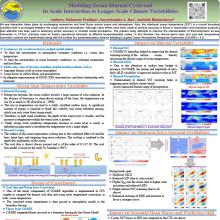Modeling Ocean Diurnal Cycle and its Scale Interaction to Longer Scale Climate Variabilities
Maheswar
Pradhan
Indian Institute of Tropical Meteorology, Pune, India
Poster
The variability at diurnal to seasonal scale in coupled models is primarily governed by surface boundary conditions (sea surface temperature (SST), turbulent heat, and momentum fluxes) between the ocean and atmosphere. Although efforts have been made to achieve the accuracy in surface fluxes and SST in observation and reanalysis products, less attention has been paid towards achieving similar accuracy in coupled model simulations. Improper diurnal phase and amplitude in intra-daily SST and precipitation are among the well-known problems in most global coupled general circulation models, including the Climate Forecast System v2(CFSv2) model. The present study attempts to improve the representation of ocean-atmosphere surface boundary conditions in CFSv2, primarily used for India’s operational forecasts at different temporal/spatial scales. In this direction, the diurnal warm layer and cool skin temperature correction scheme is implemented along with the surface flux parameterization scheme following Coupled Ocean-Atmosphere Response Experiment (COARE) v 3.0. The coupled model re-forecasts with a revised flux scheme resulted in improved characteristics in various ocean-atmosphere parameters and processes at diurnal and seasonal time scales. At the diurnal scale, the phase and amplitude of intra-daily SST and mixed layer depth variabilities are improved over most tropical Oceans. Improved diurnal SSTs helped in enhancing the diurnal range of precipitation by triggering stronger intra-daily convection. The improved diurnal ocean-atmospheric boundary state translated into a reduction in seasonal mean dry bias over Indian landmass and the wet bias over global oceans. Better simulation of El Niño–Southern Oscillation (ENSO) and Indian Ocean Dipole (IOD) related non-linearity, ENSO-Indian Summer Monsoon Rainfall (ISMR), and IOD-ISMR relation is among the most critical improvements achieved by revising the turbulent flux parameterization. The revised flux parameterization can significantly enhance India’s prediction capability at short and extended range predictions for features like diurnal extreme rainfall events, monsoon intraseasonal oscillations, Madden‐Julian Oscillation, etc.

maheswar_pradhan.pdf
(3.3 MB)
Meeting homepage
